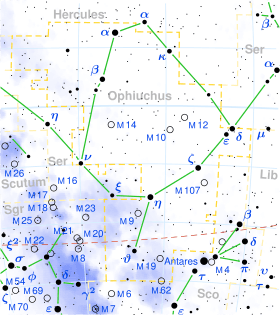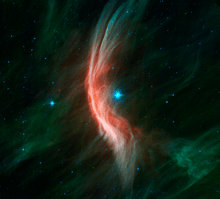Zeta Ophiuchi
Zeta Ophiuchi (ζ Oph, ζ Ophiuchi) is a star located in the constellation of Ophiuchus. It has an apparent visual magnitude of 2.57,[2] making it the third-brightest star in the constellation. Parallax measurements give an estimated distance of roughly 366 light-years (112 parsecs) from the Earth.[1]
 | |
| Observation data Epoch J2000 Equinox J2000 | |
|---|---|
| Constellation | Ophiuchus |
| Right ascension | 16h 37m 09.53905s[1] |
| Declination | –10° 34′ 01.5295″[1] |
| Apparent magnitude (V) | 2.569[2] |
| Characteristics | |
| Spectral type | O9.5 V[3] |
| U−B color index | –0.857[2] |
| B−V color index | +0.032[2] |
| Variable type | β Cep[3] |
| Astrometry | |
| Radial velocity (Rv) | –15.0[4] km/s |
| Proper motion (μ) | RA: +15.26[1] mas/yr Dec.: +24.79[1] mas/yr |
| Parallax (π) | 8.91 ± 0.20[1] mas |
| Distance | 366 ± 8 ly (112 ± 3 pc) |
| Absolute magnitude (MV) | –4.2[5] |
| Details | |
| Mass | 20.0[5] M☉ |
| Radius | 8.5[5] R☉ |
| Luminosity | 91,000[5] L☉ |
| Surface gravity (log g) | 3.58[5] cgs |
| Temperature | 34,000[5] K |
| Rotational velocity (v sin i) | 400[3] km/s |
| Age | 3.0 ± 0.3[6] Myr |
| Other designations | |
| Database references | |
| SIMBAD | data |
Properties
ζ Ophiuchi is an enormous star with more than 19[6] times the Sun's mass and eight[7] times its radius. The stellar classification of this star is O9.5 V,[3] with the luminosity class of V indicating that it is generating energy in its core by the nuclear fusion of hydrogen. This energy is being emitted from the outer envelope at an effective temperature of 34,000K,[7] giving the star the blue hue of an O-type star.[8] It is rotating rapidly and may be close to the velocity at which it would begin to break up. The projected rotational velocity may be as high as 400[3] km s−1 and it may be rotating at a rate of once per day.
This is a young star with an age of only three million years.[6] Its luminosity is varying in a periodic manner similar to that of a Beta Cephei variable. This periodicity has a dozen or more frequencies ranging between 1–10 cycles per day.[3] In 1979, examination of the spectrum of this star found "moving bumps" in its helium line profiles. This feature has since been found in other stars, which have come to be called ζ Oph stars. These spectral properties are likely the result of non-radial pulsations.[9]
This star is roughly halfway through the initial phase of its stellar evolution and will, within the next few million years, expand into a red supergiant star wider than the orbit of Jupiter before ending its life in a supernova explosion, leaving behind a neutron star or pulsar. From the Earth, a significant fraction of the light from this star is absorbed by interstellar dust, particularly at the blue end of the spectrum. In fact, were it not for this dust, ζ Ophiuchi would shine several times brighter and be among the very brightest stars visible.[10]
X-ray emissions have been detected from Zeta Ophiuchi that vary periodically. The net X-ray flux is estimated at 1.2 × 1024 W. In the energy range of 0.5–10 keV, this flux varies by about 20% over a period of 0.77 days. This behavior may be the result of a magnetic field in the star. The measured average strength of the longitudinal field is about 14.1 ± 4.5 mT.[3]

ζ Ophiuchi is moving through space with a peculiar velocity of 30 km s−1. Based upon the age and direction of motion of this star, it is a member of the Upper Scorpius sub-group of the Scorpius-Centaurus Association of stars that share a common origin and space velocity.[11] Such runaway stars may be ejected by dynamic interactions between three or four stars. However, in this case the star may be a former component of a binary star system in which the more massive primary was destroyed in a Type II supernova explosion. The pulsar PSR B1929+10 may be the leftover remnant of this supernova, as it too was ejected from the association with a velocity vector that fits the scenario.[3]
Due to the high space velocity of Zeta Ophiuchi, in combination with high intrinsic brightness and its current location in a dust-rich area of the galaxy, the star is creating a bow-shock in the direction of motion. This shock has been made visible via NASA's Wide-field Infrared Survey Explorer.[12] The formation of this bow shock can be explained by a mass loss rate of about 1.1 × 10−7 times the mass of the Sun per year, which equals the mass of the Sun every nine million years.[3]
Traditional names
ζ Ophiuchi was a member of indigenous Arabic asterism al-Nasaq al-Yamānī, "the Southern Line" of al-Nasaqān "the Two Lines",[13] along with α Serpentis (Unukalhai), δ Ser (Qin, Tsin), ε Ser (Ba, Pa), δ Ophiuchi (Yed Prior), ε Oph (Yed Posterior) and γ Oph (Tsung Ching).[14]
According to the catalogue of stars in the Technical Memorandum 33-507 - A Reduced Star Catalog Containing 537 Named Stars, al-Nasaq al-Yamānī or Nasak Yamani was the title for two stars :δ Serpentis as Nasak Yamani I and ε Ser as Nasak Yamani II (exclude this star, α Ser, δ Ophiuchi, ε Oph and γ Oph)[15]
In Chinese, 天市右垣 (Tiān Shì Yòu Yuán), meaning Right Wall of Heavenly Market Enclosure, refers to an asterism which is represent eleven old states in China which is marking the right borderline of the enclosure, consisting of ζ Ophiuchi, β Herculis, γ Herculis, κ Herculis, γ Serpentis, β Serpentis, α Serpentis, δ Serpentis, ε Serpentis, δ Ophiuchi and ε Ophiuchi.[16] Consequently, the Chinese name for ζ Ophiuchi itself is 天市右垣十一 (Tiān Shì Yòu Yuán shíyī, English: the Eleventh Star of Right Wall of Heavenly Market Enclosure), represent the state Han (韓),[17][18][19] together with 35 Capricorni[20] in Twelve States (asterism).
References
- van Leeuwen, F. (November 2007), "Validation of the new Hipparcos reduction", Astronomy and Astrophysics, 474 (2): 653–664, arXiv:0708.1752, Bibcode:2007A&A...474..653V, doi:10.1051/0004-6361:20078357
- Cousins, A. W. J. (1984), "Standardization of Broadband Photometry of Equatorial Standards", South African Astronomical Observatory Circulars, 8: 59, Bibcode:1984SAAOC...8...59C
- Hubrig, S.; Oskinova, L. M.; Schöller, M. (February 2011), "First detection of a magnetic field in the fast rotating runaway Oe star ζ Ophiuchi", Astronomische Nachrichten, 332 (2): 147, arXiv:1101.5500, Bibcode:2011AN....332..147H, doi:10.1002/asna.201111516
- Wielen, R.; et al. (1999), "Sixth Catalogue of Fundamental Stars (FK6). Part I. Basic fundamental stars with direct solutions", Veröff. Astron. Rechen-Inst. Heidelb, Astronomisches Rechen-Institut Heidelberg, 35 (35), Bibcode:1999VeARI..35....1W
- Howarth, I. D.; Smith, K. C. (2001). "Rotational mixing in early-type main-sequence stars". Monthly Notices of the Royal Astronomical Society. 327 (2): 353. Bibcode:2001MNRAS.327..353H. doi:10.1046/j.1365-8711.2001.04658.x.
- Tetzlaff, N.; Neuhäuser, R.; Hohle, M. M. (January 2011), "A catalogue of young runaway Hipparcos stars within 3 kpc from the Sun", Monthly Notices of the Royal Astronomical Society, 410 (1): 190–200, arXiv:1007.4883, Bibcode:2011MNRAS.410..190T, doi:10.1111/j.1365-2966.2010.17434.x
- Villamariz, M. R.; Herrero, A. (October 2005), "Chemical composition of Galactic OB stars. II. The fast rotator ζ Ophiuchi", Astronomy and Astrophysics, 442 (1): 263–270, arXiv:astro-ph/0507400, Bibcode:2005A&A...442..263V, doi:10.1051/0004-6361:20052848
- "The Colour of Stars", Australia Telescope, Outreach and Education, Commonwealth Scientific and Industrial Research Organisation, December 21, 2004, retrieved 2012-01-16
- Balona, L. A.; Dziembowski, W. A. (October 1999), "Excitation and visibility of high-degree modes in stars", Monthly Notices of the Royal Astronomical Society, 309 (1): 221–232, Bibcode:1999MNRAS.309..221B, doi:10.1046/j.1365-8711.1999.02821.x
- Kaler, James B., "ZETA OPH (Zeta Ophiuchi)", Stars, University of Illinois
- de Geus, E. J.; de Zeeuw, P. T.; Lub, J. (June 1989), "Physical parameters of stars in the Scorpio-Centaurus OB association", Astronomy and Astrophysics, 216 (1–2): 44–61, Bibcode:1989A&A...216...44D
- "Runaway Star Plows Through Space". Retrieved 2011-01-24.
- Kunitzsch, P., Smart, T. (2006). A Dictionary of Modern Star names: A Short Guide to 254 Star names and Their Derivations (Second Revised ed.). Cambridge, MA: Sky Publishing. p. 31. ISBN 1-931559-44-9.
- Allen, R. H. (1963). Star Names: Their Lore and Meaning (Reprint ed.). New York, NY: Dover Publications Inc. p. 243. ISBN 0-486-21079-0. Retrieved 2010-12-12.
- Jack W. Rhoads - Technical Memorandum 33-507-A Reduced Star Catalog Containing 537 Named Stars, Jet Propulsion Laboratory, California Institute of Technology; November 15, 1971
- (in Chinese) 中國星座神話, written by 陳久金. Published by 台灣書房出版有限公司, 2005, ISBN 978-986-7332-25-7.
- Star Names - R.H.Allen p.302
- (in Chinese) 香港太空館 - 研究資源 - 亮星中英對照表 Archived January 29, 2011, at the Wayback Machine, Hong Kong Space Museum. Accessed on line November 23, 2010.
- (in Chinese) English-Chinese Glossary of Chinese Star Regions, Asterisms and Star Name Archived August 10, 2010, at the Wayback Machine, Hong Kong Space Museum. Accessed on line November 23, 2010.
- Ian Ridpath's Startales - Capricornus the Sea Goat